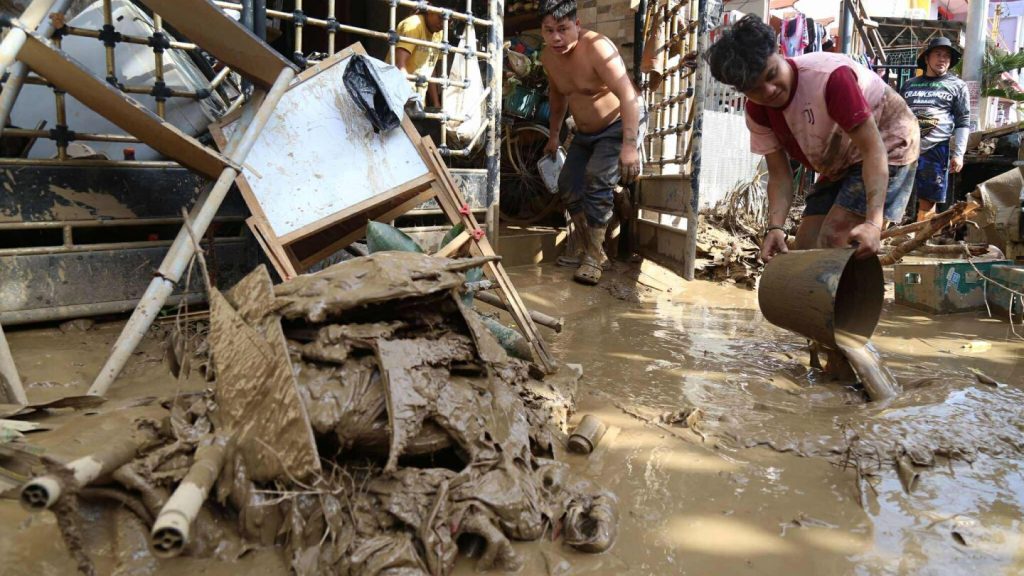Listen to the article
Deadly Typhoon Kalmaegi Devastates Philippines as Region Braces for Another Storm
Typhoon Kalmaegi has left a trail of destruction across the Philippines, killing at least 114 people with many more still missing, before making landfall in Vietnam on Friday. Meanwhile, a second typhoon, Fong-Wong, is projected to hit the Philippines around Sunday and is expected to intensify into a major storm.
The Philippines, particularly vulnerable to tropical cyclones due to its geographic location, has been struggling to cope with Kalmaegi’s aftermath as residents return to communities devastated by flooding and high winds. In Talisay City, Cebu province, locals have been sifting through damaged homes along the Mananga River, trying to salvage what remains of their possessions.
Kalmaegi ranks on the stronger side of typhoons, with maximum winds reaching 132 mph (213 kph) in the Philippines, including sustained ground winds of 93 mph (150 kph). The typhoon, known locally as Tino under the Philippines’ naming system, caused extensive damage to infrastructure and triggered widespread evacuations before continuing its destructive path toward Vietnam.
While these storms are commonly referred to as typhoons in the northwestern Pacific region, they go by different names elsewhere. In the Atlantic, Caribbean, central and northeastern Pacific, they’re called hurricanes. In the Bay of Bengal and Arabian Sea, they’re known as cyclones. Regardless of terminology, all are classified as tropical cyclones.
The northwestern Pacific, where Kalmaegi struck, is considered the most active tropical cyclone basin on Earth. “This region experiences year-round warm water, weak upper-level crosswinds, and frequent thunderstorm activity that can provide the seeds for storms to form,” explains Kristen Corbosiero, professor of atmospheric and environmental sciences at the University at Albany.
By this time of year, the Northwest Pacific typically experiences around 23 named storms, with 14 developing into typhoons. Kalmaegi and Fung-Wong mark the 26th and 27th named storms of the current season, with Kalmaegi being the 15th to reach typhoon strength. While slightly above average in frequency, Corbosiero notes this has generally been a weaker season overall. The accumulated cyclone energy—a measurement combining storm strength, frequency, and duration—shows this season at only 62% of the historical average. Kalmaegi ranks as the fourth-strongest typhoon of the season.
The timing of these storms follows typical seasonal patterns. The northwestern Pacific typhoon season runs nearly year-round, with peak activity from May to November. Vietnam commonly experiences landfalling typhoons during this period. By comparison, the Atlantic hurricane season, which runs from June 1 through November 30, has seen 13 named storms this year against an average of 14, with Hurricane Melissa causing significant destruction in Jamaica and Cuba.
Meteorologists attribute the recent surge in storm development to a weather phenomenon known as the Madden-Julian Oscillation (MJO). This natural system originates around the Indian Ocean and travels eastward, increasing rainfall and storminess in areas it passes through while suppressing thunderstorm activity behind it. The MJO can circumnavigate the globe in 30 to 60 days.
“A strong MJO can trigger tropical cyclone activity. It was active in the Northwest Pacific this summer but then weakened as the oscillation moved east,” Corbosiero explains. “A strong one recently moved through, helping with these storms’ formation.” This same weather pattern is now approaching the international dateline and could potentially trigger late-season tropical storms in the Atlantic in the coming weeks.
As communities across the Philippines continue recovery efforts, authorities are preparing for Typhoon Fong-Wong’s arrival. The Philippines employs its own storm naming convention alongside the international system maintained by the World Meteorological Organization, which explains why Kalmaegi is also referred to as Tino locally.
The back-to-back typhoons highlight the ongoing vulnerability of coastal communities throughout Southeast Asia to extreme weather events, particularly during peak storm seasons.
Fact Checker
Verify the accuracy of this article using The Disinformation Commission analysis and real-time sources.




8 Comments
Fascinating to learn about the regional differences in terminology for these powerful storms. I wonder how the meteorological criteria and impacts compare across hurricanes, cyclones, and typhoons.
It’s alarming to see the intensity of these tropical storms increasing due to climate change. Strengthening infrastructure and improving early warning systems will be essential for vulnerable regions like the Philippines.
You raise an important point. Addressing the underlying drivers of more extreme weather events should be a top priority for policymakers and disaster management agencies.
I hope the Philippines can recover quickly from the devastation of Typhoon Kalmaegi. Losing over 100 lives is truly tragic. Proper disaster planning and response will be critical in the months ahead.
Typhoons are no joke in the Philippines. Glad to see the authorities taking steps to evacuate people and minimize the damage from these powerful storms. Hoping for a quick recovery for the affected communities.
Absolutely. Typhoons can be incredibly destructive, so preparedness is key. Wishing the best for the people of the Philippines as they work to rebuild.
The differences between hurricanes, cyclones, and typhoons are fascinating. It’s amazing how these powerful weather systems can vary so much in their characteristics and impacts depending on where they form.
You’re right, the regional terminology can be confusing. But understanding the unique features of each type of tropical storm is important for staying safe and responding effectively.